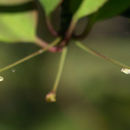en
names in breadcrumbs


Ilex mucronata, the mountain holly or catberry, is a species of holly native to eastern North America, from Newfoundland west to Minnesota, and south to Maryland and West Virginia.[1]
It was formerly treated in its own monotypic genus as Nemopanthus mucronatus (L.) Loes., known as "false holly", but transferred to Ilex on molecular data;[2] it is closely related to Ilex amelanchier.[3]
Ilex mucronata is a deciduous shrub growing to 3 m (rarely 4 m) tall (or 6 to 10 feet high from the "Manual of Woody Landscape Plants" by Dr. Michael Dirr.) The leaves are alternate, simple, elliptic to oblong, (1 to 2.5" long and 3/4's as wide) 1.5–7 cm long and 1–3 cm broad, with an entire or finely serrated margin and an acute apex, and a 0.5–2 cm (1/4 to 1/2" long) petiole. The tiny flowers about 1/5" in diameter with 4 to 5 petals are inconspicuous, whitish to greenish-yellow, produced on slender peduncles 25 mm or more long; it is usually dioecious, with male and female flowers on separate plants. The fruit is a red drupe 6–7 mm (1/4 to 1/3") diameter containing three to five pits.[4][5][6]
The plant does best in full sun, or part shade is good. It usually grows in moist or draining wet acid soils, often with the similar species of Common Winterberry, Ilex verticillata, but is also found on upland cliffs and slopes on hills and mountains. It develops a yellow autumn color. It is recommended for use in naturalistic landscapes. Its USDA hardiness zone recommendation is zones 4 to 6. The name "mountain holly" is also sometimes used for the related mountain winterberry (Ilex montana).
Ilex mucronata, the mountain holly or catberry, is a species of holly native to eastern North America, from Newfoundland west to Minnesota, and south to Maryland and West Virginia.
Le némopanthe mucroné ou Faux houx (Nemopanthus mucronatus ou Ilex mucronata) est un arbuste indigène au Québec des tourbières et des forêts ouvertes de conifères, aux feuilles légèrement dentées et terminées par une petite pointe, appelée mucron, d'où son nom.
Le nom générique signifie « fleur à pédoncule filiforme »[2].
Le némopanthe mucroné comprend des rhizomes robustes. Les tiges sont fortement ramifiées, dressées et peuvent atteindre plus de 2 m de hauteur. Les feuilles sont alternes et munies d’un pétiole de couleur lilas. Elles sont de forme elliptique, élargies au sommet, à marge entière ou munie de quelques dents au sommet et terminées par un mucron. Elles sont plutôt minces et glabres. Les fleurs mâles et femelles sont situées sur des plants différents. Elles sont solitaires ou groupées en faisceau à l’aisselle des feuilles. Elles sont jaunâtres et très petites. Les fruits sont charnus, rouge violacé et contiennent 4 ou 5 noyaux[3].
Cette espèce préfère les sols acides et humides, généralement tourbeux[3].
Les fruits ne sont cependant pas comestibles, et peuvent causer des vomissements et de la diarrhée.[3],[4].
Le némopanthe mucroné ou Faux houx (Nemopanthus mucronatus ou Ilex mucronata) est un arbuste indigène au Québec des tourbières et des forêts ouvertes de conifères, aux feuilles légèrement dentées et terminées par une petite pointe, appelée mucron, d'où son nom.
Gorska lupina (gorska božika, nemopantus, lat. Ilex mucronata), močvarni grm iz porodice Aquifoliaceae, nekada uključivan u vlastiti rod Nemopanthus, a danas rodu Ilex, odnosno božikovinama.
Domovina joj je Sjeverna Amerika, a raširena je od Newfoundlanda na zapad do Minnesote.
Na Zajedničkom poslužitelju postoje datoteke vezane uz: Gorska lupina Wikivrste imaju podatke o: Ilex mucronataIlex mucronata là một loài thực vật có hoa trong họ Aquifoliaceae. Loài này được (L.) M. Powell, Savol. & S. Andrews mô tả khoa học đầu tiên năm 2000.[1]
Ilex mucronata là một loài thực vật có hoa trong họ Aquifoliaceae. Loài này được (L.) M. Powell, Savol. & S. Andrews mô tả khoa học đầu tiên năm 2000.